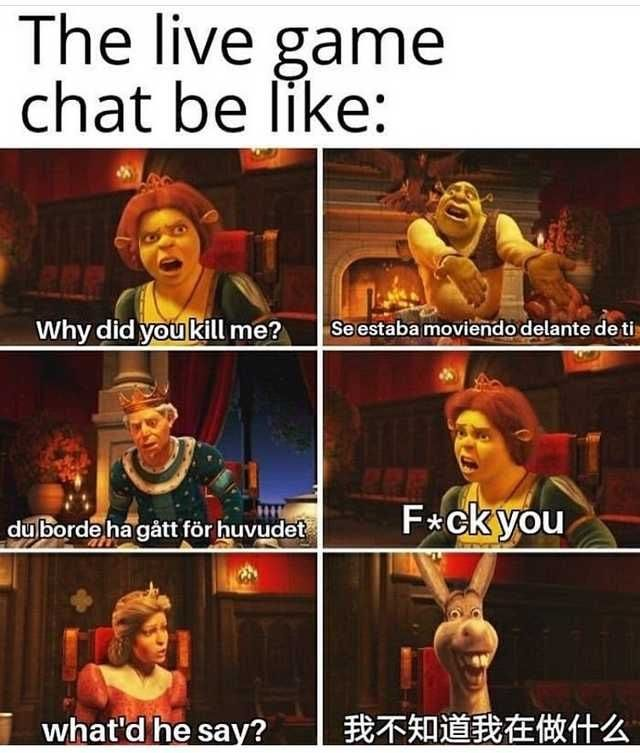Small talks; Casual conversation; in Non-Lang Specific
Activities (Lesson Plans)
Digital Games: Not Language Specific
PRACTICAL IDEAS & RESOURCES
Resources in this section curated by: Cameron Teubner-Keller

How to learn languages with video games | YouTube Video
This video discusses how video games can be used for language learning. The creator goes over possible benefits such as making studying fun, simulating immersion, exposure to rare vocabulary, and context-based learning. Dialogue-based games are more helpful than action-based games as they give the learners more exposure to the target language.

Polyglot shocks native speakers in VRChat | YouTube Video
In this video, YouTuber Ikenna, plays the virtual reality game VR Chat. Throughout the video, Ikenna interacts with expert-level speakers of multiple languages. This video showcases the great potential that games have for giving learners contexts to actually use the target language and interact with expert speakers of their target language.

VRChat Etiquette – Unspoken Rules of VRChat | Article
These "unspoken rules" for VRChat cover common game etiquette practices. People often forget that even in virtual reality, they are still interacting with real people. For teachers and learners using this game for language learning purposes, it is essential to be aware of the acceptable and appropriate norms of the community/server one is joining. This is especially important when joining servers for practicing languages, where practicing the acceptable pragmatic/cultural norms is just as important as practicing the language. Understanding digital game norms and pragmatics is also important for language learners as the internet becomes an ever-increasing part of our lives.

VR chat etiquette? | Reddit Post
This is a reddit post covering similar topics of VRChat etiquette. The comments section of the post includes a discussion by players. This would be useful for learners and teachers alike who want to ask questions before playing or simply discuss certain pragmatic points with actual players of the game.

Socializing in VR Chat | Reddit Post
This reddit user discusses how VRChat assisted him in becoming more social. The discussion in the comments is centered on how virtual reality helps a lot for people with social anxiety, which is another important element of the potential use of VR in language classrooms.
Acquisition can be anxiety-inducing for socially anxious language learners because pragmatics requires using language in situated contexts with real world consequences. Therefore, VR can be especially helpful for learners with low willingness to communicate in the classroom; VR can provide situational contexts with low-stakes yet real consequences for learners to practice their pragmatics.

Learn a Language in VR Scenarios with these Apps | Blog Post
This post reviews current virtual reality games and apps made for language learning. The author discusses the importance of immersion and how VR can make up for a lack in actual communities of practice. These games allow learners to be immersed in specific contexts and use the target language to complete tasks. Using language functions/skills in VR allows learners to connect what they are told about language to actual experiences.

Players Leap Language Barriers | New York Times Article
This article discusses the mobile game Game of War: Fire Age and its potential to translate languages in real time to allow communication between monolingual speakers of different languages. Players in the game provide translations when the automatic system can’t do it, which are then used by the system in the future to assist in future translations. Ideally learners would be using their L2, so it is possible for learners to set the game up to translate into their L2 or to turn off the translator in general. However, there are still benefits from seeing how translations might differ slightly from expert language use, and intercultural pragmatic communication is still present.

Mondly AR: Augmented Reality Language Learning | Mobile Game
Mondly AR is a mobile augmented reality language-learning game. It uses mobile phones as a lens for augmenting reality. This game assists in learning a language by adding random objects, such as animals, into a nearby space that can be viewed through the phone. The game also provides "real-life" conversation with their AI bot, "Mondly". The AI uses gestures and facial expressions along with the target language to create dynamic interactions. It also gives instant feedback on pronunciation. This app could be a possible language learning game that could be implemented into classroom instruction.

Using MMOGs for Language Learning | YouTube Video
This video from the CASLS center at the University of Oregon explains how one can use MMOGs for language learning. A step-by-step guide is included on how to get started, from finding a game that has players who use the target language, to learning the game through guides in the target language, to observing other players' language use, and finally playing along using the target language!

Live Game Chat | Meme

This is a meme depicting multilingualism in the gaming community. It shows how gaming can be a great context for learners to have exposure to different languages as well as how they can use their L2s to express themselves in communicative ways.

Fanfic Etiquette? | Reddit Post
This reddit user requested information about etiquette for fanfic websites, asking questions such as:
- Is it considered lame to reply to reviews?
- Is it creepy/stalkery to leave kudos or comments on the same "fic"?
- Do you want to know if you made a grammar mistake?
These questions demonstrate how even websites such as fan fiction sites have their own pragmatics and appropriate discourse skills. The use of words such as lame or creepy show that the reddit user is considering the perlocutionary effects of their writing, or how they will be perceived by others in the community. This is an example of how participating on these sites can be helpful for practicing writing skills, especially if people point out grammar mistakes, as the comments on the post imply.

Learning by playing: serious game teaches intercultural skills | YouTube Video
This YouTube video showcases a game being used by the ESCP Europe Business School to teach students intercultural skills. In this case, it specifically teaches intercultural management and workplace skills, which are still pragmatic skills that language learners must learn as well. Video game usage provides versatility for teaching intercultural communication skills.

Ikenna | YouTube Channel
This channel was created by a man who enjoys learning languages. He currently knows 7 languages, makes videos about playing video games, and interacts with speakers of other languages. He is currently creating his own language learning game. In his videos, he utilizes his language skills to have intercultural, multilingual interactions. In doing so, he is also learning pragmatic skills required to speak in those languages. By speaking with expert speakers of languages, he refines his own language skills.

Is It Possible To Learn A Language Playing Video Games? | Article
This article discusses the use of video games for language learning. Video games provide in-context learning, repetition, and listening and reading practice. They often have related digital spaces where people interact with those who speak the target language (online forums, message boards, etc.). The article describes in detail different gaming platforms and how to get access to games in a target language, as well as specific games and their language options.

Learn or Die! 5 Epic Ways to Learn Languages by Playing Video Games | Blog Post
This blog post discusses how one can learn languages with video games. However, this one focuses heavily on popular commercial games such as Call of Duty and Borderlands. Although it includes apps and children's games, the article focuses heavily on commercial games, their available languages, and why learners might be interested in them.

Escape From Byru’Moxia | Online Game
This game focuses on intercultural competence and uses a game-like narrative to teach learners how pragmatic factors such as power, social distance, and severity might show up in language use. By playing, learners become aware of how these dynamics present themselves in everyday communication. Players solve puzzles related to these pragmatic factors to be able to move forward in the game, which helps them learn appropriateness of language choices based on illocutionary and perlocutionary effects.
ACADEMIC RESOURCES FOR DIGITAL GAMES
Not Language-Specific
Resources in this section curated by: Anna Krinitsyna, Cameron Teubner-Keller
Holden, C.L., Knight, S., & Sykes, J.M. (2019). Communities: Exploring digital games and social networking. Engaging Language Learners through CALL, 10. 353-389.
Digital games are capable of providing community connection within language teaching and learning. MMOGs allow people to simultaneously interact, compete, and collaborate with one another, which allows learners to become meaningful, dynamic members of a variety of game-related communities and build intercultural relationships. Place-based, augmented reality mobile games engage learners with a place and its associated community, which establishes connections between place, community, culture, and language.
It is essential that in the acquisition of a second language, learners become adept multilingual speakers in both academic contexts and prominent social spaces. Through digital games and online social spaces, learners have opportunities to acquire pragmatic, literacy, and intercultural skills along with linguistic development of lexical, syntactic, pragmatic, and discourse knowledge.
In designing tasks involving these mediums for language learning, there are three essential stages: observation, analysis, and extension. Learners need to first observe and be aware of social practices, discourse and products relating to the community, then analyze artifacts that they observe and collect to understand and develop skills for the community, and finally extend and apply the skills they’ve observed and analyzed to meaningful contexts. Assessment should be based on the capacity of learners to move beyond collection of knowledge to appropriate extension and application of that knowledge.
Reinhardt, J., & Sykes, J. M. (2012). Conceptualizing digital game-mediated L2 learning and pedagogy: Game-enhanced and game-based research and practice. In Digital games in language learning and teaching (pp. 32-49). London: Palgrave Macmillan UK. https://doi.org/10.1057/97811370
This article discusses L2 learning and pedagogy with reference to game-enhanced and game-based language learning. Game-enhanced looks at use of commercial games as affording learners the spaces for L2 acquisition. Game-based looks at the use of games specifically designed for L2 learning and acquisition.
Game-enhanced learning provides learners with a huge population of expert level speaking interlocutors; there is a plethora of natural interaction for the learner to be a part of. The games are also cultural products themselves, providing exposure to cultural discourses and narratives.
Game-based learning can target specific learning objectives more easily and provide learners with all the tools they’ll need to learn language. Task design, interaction, and feedback type & presentation are essential for successful game-based language learning. The way in which feedback is given is extremely important. Feedback must be scaffolded and targeted for the individual learner so they are challenged, but have the necessary tools to survive and overcome the challenge.
Sykes, J. M. (2017). Technologies for teaching and learning intercultural competence and interlanguage pragmatics. The handbook of technology and second language teaching and learning, 118-133. https://doi.org/10.1002/9781118914069.ch9
Technology can be used to teach and learn intercultural competence (ICC) and interlanguage pragmatics (ILP). ICC encompasses attitudes, knowledge, skills of interpreting and relating, skills of discovery and interaction, critical cultural awareness, and critical cultural education. Transnational languaculture transcends national boundaries to describe ICC from the perspective of the individual. This approach covers three aspects: language and languaculture, topics and discourses, and contexts and contacts, all of which have connections to technology and the teaching and learning of pragmatics.
In the teaching of pragmatics, teachers might use digitally-mediated communication spaces (forums, fanfiction sites, digital games, etc.) as ways for learners to be exposed to native-like patterns of language use. Learners can review pragmatic practices relevant to themselves through digital spaces like gaming, forums, YouTube videos, etc. Technologies and digital spaces also give learners access to target language and culture and allow learners to interact with communities where the target language is spoken and used. Other possible topics for teaching and learning pragmatics could be the analysis of hashtags, analysis of social networks and how interaction occurs on them, or analysis of the complex pragmatic behaviors in social media contact zones (YouTube commentaries, Flickr photo reviews, etc.).
Sykes, J. M. (2018). Digital games and language teaching and learning. Foreign Language Annals, 51(1), 219-224. https://doi.org/10.1111/flan.12325
Gaming is increasingly becoming a common activity for many people, whether it be for educational or recreational purposes. With the increased access to digital games, there is an increase in opportunities for game-enhanced and game-based learning; that is learning through commercial games or through games specifically built for teaching and learning of world languages. Digital games provide opportunities for creation of learning communities in which learners have access to diverse and complex written and spoken discourse, as well as authentic language socialization and practice.
Community-based games, virtual reality games, and commercial games all provide teachers with opportunities to create engaging in-class activities around group work and out-of-class assignments. There are 5 relevant features of games for language teaching and learning; learner-directed goal orientation; opportunities for interactions with the game, through the game, and around the game; well-timed individualized feedback; relevant contexts and narratives; and motivation.
Sykes, J. M. (2018). Interlanguage pragmatics, curricular innovation, and digital technologies. Calico Journal, 35(2), 120-141. https://www.jstor.org/stable/90021915
This article examines the benefits that digital technologies provide for the instruction of pragmatic skills in language learning. It looks at how digital curricula, classroom interventions, telecollaboration, research methods, and augmented digital contexts all promote interlanguage pragmatic skills. Since meaning is encoded in many aspects of communication (sequencing, turn taking, gesture, etc.) it’s important that learners have access to communication and interaction for the development of ILP.
Digital curricula provide pragmatic learning materials that are dynamic and widely accessible. Digital technologies allow for classroom interventions at just the right time that give learners individualized environmental feedback in meaningful scenarios. Telecollaboration enables learners to tackle pragmatic issues both as tasks and topics, but also as a function of their interactions. It affords opportunities for interaction, analysis, and reflection. Digital technologies have also expanded the methodologies for research on ILP. Augmented digital contexts are also important for learners as they are contexts with their own pragmatic behaviors.
Sykes, J. M. (2019). Emergent Digital Discourses: What Can We Learn From Hashtags and Digital Games to Expand Learners’ Second Language Repertoire? Annual Review of Applied Linguistics, 39, 128-145. doi:10.1017/S0267190519000138
The study of hashtags can be beneficial for pragmatic development. The author of this article explores different functions of hashtags, tools to study hashtag trends, and activities learners can do with hashtags. A large portion of the article is dedicated to using hashtags with digital games. These include interactions with games, through games, around games, and about games. A further analysis is given to digital discourse.
This article would be helpful to teachers and learners who are interested not only in using hashtags for pragmatic learning, but also in using games for learning and exploring digital discourse in general.
Sykes, J. M., AnaOskoz, & Thorne, S. L. (2008). Web 2.0, synthetic immersive environments, and mobile resources for language education. Calico Journal, 25(3), 528-546. https://www.jstor.org/stable/pdf/calicojournal.25.3.528.pdf?casa_token=tJZmaEJjW80AAAAA:1I7OX-yqXXpLGkRM-hzEJv8XOoDBR2a0dOoO-XrYxeVRuOlgb8Jefc7X1wHadv-lumT8ew2IK_dHRbcrISo858lqZqepqf_HATvwUUTDF0REld-yiX1YNg
As technology expands into the educational setting, it is important to note how technology can be used to assist second language (L2) learners in the acquisition of L2 pragmatics. CALL (computer-assisted language learning) can include the usage of wikis, blogs, online gaming, or SIEs (synthetic immersive environments), all of which have potential for strengthening L2 skills and intercultural communicative competence. Wikis can be used to have learners work (a)synchronously to negotiate and share knowledge in an interactive activity. Blogs can assist learners in their L2 writing skills and even incorporate interaction through comments and responses.
Both MMOGs and SIEs also have potential to give learners opportunities to practice their L2 pragmatics. In MMOGs, learners can practice sociopragmatic skills by creating an avatar with specific characteristics that alter the norms of communication. Social experimentation is an inherent characteristic of these games, as shown by single players creating multiple characters to have new experiences. Learners can also practice with repairs, greetings, requests, leave-takings, and solidarity building.
SIEs incorporate aspects of MMOGs with specific focus on educational objectives. Through SIEs, learners have the opportunity to practice authentic communication in a low-risk environment. Learners also will start seeing what impacts their language choices have in communication.
Thorne, S. L., Black, R. W., & Sykes, J. M. (2009). Second language use, socialization, and learning in Internet interest communities and online gaming. The Modern Language Journal, 93, 802-821. https://doi.org/10.1111/j.1540-4781.2009.00974.x
Online communities like fan fiction groups and online gaming groups are great opportunities for language learners to experience varied forms of L2 engagement, development, and socialization. Many language varieties have developed through the use of online media. “The remix, plurilingual, and emergent nature” of these varieties highlights the focus of language learning on meaning and use for the performance of desired identities and the development of discourse repertoires. The combination of language socialization and implicit or explicit feedback supports the acquisition of linguistic forms, communicative strategies, and resources for performing relevant social identities.
Online fan fiction communities promote informal, participatory types of learning that are beneficial for L2 literacy development, sense of self-efficacy, and level of affiliation. Research shows that learners are capable of internalizing the impact of their identity choices in virtual worlds, therefore proposing the idea that participation in social virtual realities has the potential to aid learners in the acquisition of sociocultural analytical skills. MMOGs involve everyday talk and goal-directed play that generates attendant social activity. Participants’ motives for foreign language-learning could include a desire to participate in these online multilingual communities.
Thorne, S. L., Sauro, S., & Smith, B. (2015). Technologies, identities, and expressive activity. Annual Review of Applied Linguistics, 35, 215-233. https://doi.org/10.1017/S0267190514000257
This article discusses how L2 learners can construct and negotiate identities through technologies and digital spaces. The internet has changed the way everyday communication occurs, and as such, L2 learners should be provided with guidance on intercultural communication and identity building through digital mediums. Both situated and transportable identities (expected roles and cultural characteristics) are intertwined with the norms and affordances of technological interaction.
Technologies allow language instructors to function as designers, guides, and facilitators, while making language learners active learners, team builders, and collaborators. Agency and identity are the major principles present in online interaction and technology use by learners. Use of online spaces for L2 learning and intercultural communication gives opportunities for learners to work on their own subjectivity, and either acceptance or rejection of pragmatic norms.
